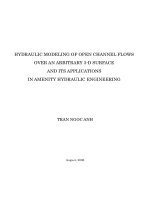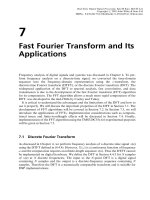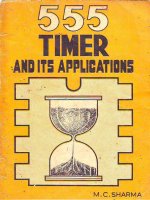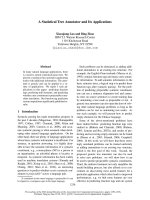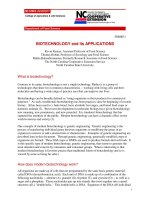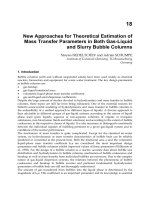Microarray Technology and Its Applications pptx
Bạn đang xem bản rút gọn của tài liệu. Xem và tải ngay bản đầy đủ của tài liệu tại đây (24.17 MB, 388 trang )
biological and medical physics,
biomedical eng ineering
biological and medical physics,
biomedical eng ineering
The fields of biological and medical physics and b iomedical engineering are broad, multidisciplinary and
dynamic. They lie at the crossroads of frontier research in physics, biology, chemistry, and medicine. The
Biological and Medical Physics, Biomedical Engineering Series is intended to be comprehensive, covering a
broad range of topics important to the study of the physical, chemical and biological sciences. Its goal is to
provide scientists and engineers with textbooks, monographs, and reference works to address the growing
need for informa tion.
Books in the series emphasize established and emergent areas of science including molecular, membrane,
and mathematical biophysics; photosynthetic energy harvesting and conversion; information processing;
physical principles of genetics; sensory communications; automata networks, neural networks, and cellular
automata. Equally important will be coverage of applied aspects of biological and medical physics and
biomedical engineering such as molecular electronic components and devices, biosensors, medicine, imaging,
physical principles of renewable energy production, advanced prostheses, and environmental control and
engineering.
Editor-in-Chief:
Elias Greenbaum, Oak Ridge National Laboratory,
Oak Ridge, Tennessee, USA
Editorial Board:
Masuo Aizawa, Department of Bioengineering,
Tokyo Institute of Technology, Yokohama, Japan
Olaf S. Andersen, Department of Physiology,
Biophysics & Molecular Medicine,
CornellUniversity,NewYork,USA
Robert H. Austin, Department of Physics,
Princeton University, Princeton, New Jersey, USA
James Barber, Department of Biochemistry,
Imperial College of Science, Technology
and Medicine, London, England
Howard C. Berg, Department of Molecular
and Cellular Biology, Harvard University,
Cambridge, Massachusetts, USA
Victor Bloomfield, Department of Biochemistry,
University of Minnesota, St. Paul, Minnesota, USA
Robert Callender, Department of Biochemistry,
Albert Einstein College of Medicine,
Bronx, New York, USA
Britton Chance, Department of Biochemistry/
Biophysics, University of Pennsylvania,
Philadelphia, Pennsylvania, USA
Steven Chu, Department of Physics,
Stanford Univ ersity, Stanfor d, California, USA
Louis J. DeFelice, Department of Pharmacology,
Vanderbilt University, Nashville, Tennessee, USA
Johann Deisenhofer, Howard Hughes Medical
Institute, The University of Texas, Dallas,
Texas, USA
George Feher, Department of Physics,
University of California, San Diego, La Jolla,
California, USA
Hans Frauenfelder, CNLS, MS B258,
Los Alamos National Labora tory, Los Alamos,
New Mexico, USA
Ivar Giaever, Rensselaer Polytechnic Institute,
Troy,NewYork,USA
Sol M. Gruner, Department of Physics,
Princeton University, Princeton, New Jersey, USA
Judith Herzfeld, Department of Chemistry,
Brandeis University, Waltham, Massachusetts, USA
Pierre Joliot, Institute de Biologie
Physico-Chimique, Fondation Edmond
de Rothschild, Paris, France
Lajos Keszthelyi, Institute of Biophysics, Hungarian
Academy of Sciences, Szeged, Hungary
Robert S. Knox, Department of Physics
and Astronomy, University of Rochester, Rochester ,
New York, USA
Aaron Lewis, Department of Applied Physics,
Hebrew University, Jerusalem, Israel
Stuart M. Lindsay, Department of Physics
and Astronomy, Arizona State University,
Tempe, Arizona, USA
David Mauzerall, Rockefeller University,
New York, New York, USA
Eugenie V. Mielczarek, Department of Physics
and Astronomy, George Mason University, Fairfax,
Virginia, USA
Markolf Niemz, Klinikum Mannheim,
Mannheim, Germany
V. Adrian Parsegian, Physical Science Laboratory,
National Institutes of Health, Bethesda,
Maryland, USA
Linda S. Powers, NCDMF: Electrical Engineering,
Utah State University, Logan, Utah, USA
Earl W. Pr ohofsky, Department of Physics,
Purdue University, West Lafayette, Indiana, USA
Andrew Rubin, Department of Biophysics, Moscow
State Uni versity, Moscow, Russia
Michael Seibert, National Renewable Energy
Laboratory, Golden, Colorado, USA
David Thomas, Department o f Biochemistry,
University of Minnesota Medical School,
Minneapolis, Minnesota, USA
Samuel J. Williamson, Department of Physics,
New York University , New York, New Yo rk, USA
U.R. M
¨
uller D.V. Nicolau (Eds.)
Microarray Technology
and Its Applications
With 123 Figures
Including 16 Color Plates
123
Uwe R. M
¨
uller, Ph.D.
V. P. , App l ie d S c ie n ce
Nanosphere, Inc.
4088 Commercial Avenue
Northbrook, IL 60062
USA
e-mail:
Prof. Dan V. Nicola u
Swinburne University of Technology
533-545 Burwood Rd.
Hawthorn, Victoria 3122
Australia
e-mail:
Library of Congress Cataloging in Publication Data: 2004113284
ISSN 1618-7210
ISBN 3-540-22931-0 Springer Berlin Heidelberg New York
This work is subject to copyright. All rights are reserved, whether the whole or part ofthematerial is concerned,
specifically the rights of translation, reprinting, reuse of illustrations, recitation, broadcasting, reproduction
on microfilm or in any other way, and storage in data banks. Duplication of this publication or parts thereof is
permitted only under the provisions of the German Copyright Law of September 9, 1965, in its current version,
and permission for use must always be obtained from Springer. Violations are liable to prosecution under the
German Copyright Law.
Springer is a part of Springer Science+Business Media
springeronline.com
© Springer-Verlag Berlin Heidelberg 2005
Printed in Germany
The use of general descriptive names, registered names, trademarks, etc. in this publication does not imply,
even in the absence of a specific statement, that such names are exempt from the relevant protective laws and
regulations and therefore free for general use.
Cover concept by eStudio Calamar Steinen
Typesetting by the authors using a Springer L
A
T
E
X-macro package
Cover production: design & production GmbH, Heidelberg
Production: LE-T
E
X Jelonek, Schmidt & Vöckler GbR, Leipzig
Printed on acid-free paper SPIN 10884448 57/3141/YL - 5 4 3 2 1 0
Preface
It has been stated that our knowledge doubles every 20 years, but that may be
an understatement when considering the Life Sciences. A series of discoveries
and inventions have propelled our knowledge from the recognition that DNA
is the genetic material to a basic molecular understanding of ourselves and the
living world around us in less than 50 years. Crucial to this rapid progress was
the discovery of the double-helical structure of DNA, which laid the foundation
for all hybridization based technologies. The discoveries of restriction enzymes,
ligases, polymerases, combined with key innovations in DNA synthesis and
sequencing ushered in the era of biotechnology as a new science with profound
sociological and economic implications that are likely to have a dominating
influence on the development of our society during this century. Given the
process by which science builds on prior knowledge, it is perhaps unfair to
single out a few inventions and credit them with having contributed most to
this avalanche of knowledge. Yet, there are surely some that will be recognized
as having had a more profound impact than others, not just in the furthering
of our scientific knowledge, but by leveraging commercial applications that
provide a tangible return to our society.
The now famous Polymerase Chain Reaction, or PCR, is surely one of
those, as it has uniquely catalyzed molecular biology during the past 20 years,
and continues to have a significant impact on all areas that involve nucleic
acids, ranging from molecular pathology to forensics. Ten years ago microar-
ray technology emerged as a new and powerful tool to study nucleic acid se-
quences in a highly multiplexed manner, and has since found equally exciting
and useful applications in the study of proteins, metabolites, toxins, viruses,
whole cells and even tissues. Although still relatively early in its evolution,
microarray technology has already superseded PCR technology not only in the
breadth of applications, but also in the speed with which this evolution has
taken place. Note that the literature dealing with microarrays has increased
dramatically from its humble beginnings in the mid-nineties to reach more
than 2000 articles and almost 300 reviews in 2004 alone (Fig 1). Although a
saturation point may have been reached - not surprisingly given that there is
VI Preface
still a limit to the number of laboratories that have access to this technology-
its impact is truly remarkable, especially when compared, for example, to the
emerging and much touted field of Nanotechnology.
Number of Articles
Number of Reviews
Fig. 1. Comparative evolution of publications regarding microarrays and
nanobiotechnology
Amidst the pace of such rapid knowledge expansion, there is a challenge
in trying to compose a book that does not face obsolescence by the time
of its first publication. Alas, the breadth of this field is driving the growing
knowledge base into many new directions, generating the need for different
books at different levels and each with a different and unique focus.
As early participants in the development of microarray technology the edi-
tors have learned to appreciate the need for contributions from many different
areas in the basic sciences and engineering that were crucial to its birth and
continued healthy growth. In turn we have observed how the involvement in
this particular scientific endeavour has affected many careers, turning physi-
cist into oncologists, physicians into bioinformaticians, and chemists and biol-
ogists into optical engineers. Provided the diverse nature of backgrounds that
are required to further propel this field, we thought it appropriate to aggre-
gate this book around three aspects of microarray technology: fundamentals,
designed to provide a scientific base; fabrication, which describes the current
state of the art and compares ‘old’ and new ways of building microarrays; and
applications, that are aimed to highlight only the amazing variety and options
provided by these techniques. As an aid to the practitioner we have also asked
the authors to provide a detailed method section wherever appropriate.
Part 1, General Microarray Technologies, opens with an overview on mi-
croarray formats. Chapters 2 and 3 cover the fundamentals of the physico-
chemical aspects of immobilizing biomolecules on different substrates, while
Preface VII
Chaps. 4 and 5 describe the principal techniques used for array manufac-
ture. Chapter 6 explores the limits of miniaturization with nanoarrays, and
Chap. 7 illuminates various aspects of microfluidics for automation. Finally,
Chaps. 8 and 9 deal with the principles of labelling and detection method-
ologies. The next parts are concerned with application of these fundamental
techniques toward the development and use of specific types of microarrays.
Part 2 describes DNA based microarrays in 4 chapters, covering SNP detec-
tion, high sensitivity expression profiling, comparative genomic hybridization,
and the analysis of regulatory circuits. Part 3 contains 3 chapters that deal
with microarrays for protein and small molecule detection, describing array
technology for antibodies, aptamers, and lipid bound proteins, respectively.
The final part comprises 4 chapters that introduce the most esoteric arrays,
those that contain high information content in each feature (whole cells or
tissues), and the capability of performing biological reactions, such as trans-
fections. How the combination of these types of arrays generates new insights
into the molecular basis of normal and malignant cell function is summarized
in the last chapter.
It appears that given the dynamics of microarray technology any book
would be a ‘work in progress’. Rather than fighting this, the editors and the
authors of this book embrace this concept: chances are that this book will
grow in time in line with the new developments in microarray technology.
June, 2004 Uwe M¨uller
Dan Nicolau
Acknowledgements
The initial idea for this book emerged during a serendipitous meeting between
the Editors and a representative from Springer Verlag during a Conference on
Microarrays, Fundamentals, Fabrication and Applications that was chaired
and organized by the Editors as part of the International Society for Optical
Engineering (SPIE) Meeting in January 2001 in San Jose, CA. In fact, sev-
eral Chaps. of this book were authored by people present at that Conference.
The Editors wish to thank the organizers of SPIE, and in particular Mar-
ilyn Gorsuch and Annie Gerstl, who helped with the organisation of these
Conferences in the last four years. Thanks also to the Conference co-Chairs,
Ramesh Raghavachari and David Dunn. The Editors also wish to thank Pe-
ter Livingston and Gerardin Solana for the tedious work of converting the
manuscripts into a camera-ready format.
Many contributors have specific acknowledgements.
The authors of Chap. 1 are grateful to Stephen Felder, Ph.D. and Richard
Kris, Ph.D. of NeoGen, LLC. (Tucson, AZ), the inventors of the multiplexed
nuclease protection assay, for proof-of-principle work on the mRNA assay and
for the software for reagent design, image analysis and data interpretation.
The authors of Chap. 4 would like to thank Innovadyne Technologies for
use of Fig. 4.5 and Peter Hoyt for helpful discussions. The research pre-
sented here was sponsored by the Laboratory Directed Research and Devel-
opment Program of Oak Ridge National Laboratory (ORNL), managed by
UT-Battelle, LLC for the U. S. Department of Energy under Contract No.
DE-AC05-00OR22725 and by NIH Grant R01 HL62681-02. The manuscript
has been authored by a contractor of the U.S.Government under contract
DE-AC05-00OR22725. Accordingly, the U.S. Government retains a nonexclu-
sive, royalty-free license to publish or reproduce the published form of this
contribution, or allow others to do so, for U.S. Government purposes.
One of the authors of Chap. 6 (DVN) wishes to thank Dan V. Nicolau Jr.
for discussions regarding the computational applications of nanoarrays.
The authors of Chap. 7 would like to thank Joe Bonanno and Dale Ganser
(formerly Motorola Labs) for help in device fabrication, and Gary Olsen and
X Acknowledgements
Pankaj Singhal (Motorola Life Sciences) for useful discussions on hybridiza-
tion kinetics. This work has been sponsored in part by NIST ATP contract
#1999011104A and DARPA contract #MDA972-01-3-0001.
Some of the authors of Chap. 8, i.e. JJS and SSM, acknowledge the NIH for
support. CAM acknowledges the AFOSR, DARPA, and the NSF for support
of this work.
The authors of Chap. 9 are very grateful to Gabriele G¨unther for excellent
technical assistance, to Dr. K. B¨ohm, Jena, for kindly providing us with mi-
crotubules and kinesin samples, and to Dr. Wolf, PicoRapid GmbH Bremen,
for help in spotting protein samples by an automatic arrayer.
The authors of Chap. 13 thank Dr. Tae Hoon Kim and Miss Sara Van
Calcar for critical reading of the manuscript. We are also grateful to Drs.
Hieu Cam, Yasuhiko Takahashi, Brian Dynlacht, Richard Young, and Mr. Tom
Volkert for their help during the development of the technology described in
this chapter. B.R. is supported by the Ludwig Institute for Cancer Research
and a Sidney Kimmel Foundation for Cancer Research Scholar Award.
The authors of Chap. 14 wish to acknowledge the great support by Dr.
Ronald Frank.
Finally, the authors of Chap. 20 thank Juha Kononen, Guido Sauter, Hol-
ger Moch, Lukas Bubendorf, Galen Hostetter, Ghadi Salem, John Kakareka
and Tom Pohida for their contribution to the tissue microarray development,
and Robert Cornelison, Don Weaver, Abdel Elkhahloon, and Natalie Gold-
berger and for their contributions to the cell microarrays.
Contents
Part I General Microarray Technologies
1 Array Formats
Ralph R. Martel, Matthew P. Rounseville, Ihab W. Botros,
Bruce E. Seligmann 3
1.1 Introduction 3
1.2 ReasonstoUseArrays 4
1.3 Arrays for NucleicAcidAnalysis 6
1.4 ProteinArrays 8
1.5 The ArrayPlate
TM
9
1.6 Conclusion 19
References 20
2 Biomolecules and Cells on Surfaces –
Fundamental Concepts
Kristi L. Hanson, Luisa Filipponi, Dan V. Nicolau 23
2.1 Introduction 23
2.2 Types of Immobilization . . . 23
2.3 DNA Immobilization on Surfaces. . . 28
2.4 Protein Immobilization on Surfaces . . . 32
2.5 Carbohydrate Immobilization 36
2.6 Immobilization of Cells on Surfaces 38
2.7 Conclusions 41
References 42
3 Surfaces and Substrates
Alvaro Carrillo, Kunal V. Gujraty, Ravi S. Kane 45
3.1 Introduction 45
3.2 DNAMicroarrays 46
3.3 ProteinMicroarrays 50
XII Contents
3.4 Conclusion 55
References 56
4 Reagent Jetting Based Deposition Technologies
for Array Construction
Mitchel J. Doktycz 63
4.1 Introduction 63
4.2 ReagentJetting–TechnologyOverview 63
4.3 ThermalJetBased Dispensing 65
4.4 PiezoJetBasedDispensing 67
4.5 SolenoidJetBasedDispensing 68
References 71
5 Manufacturing of 2-D Arrays by Pin-printing Technologies
Uwe R. M¨uller, Roeland Papen 73
5.1 Introduction 73
5.2 Definitionof ‘Contact’Pin–Printing 73
5.3 OverviewofDifferent PinTechnologies 74
5.4 OtherSystemComponentsandEnvironmentalFactors 79
5.5 Pin Printing Process 81
5.6 Example of a High Throughput Pin–Printing System for
Manufacturing of 2D Arrays – the Corning GENII System . . . 84
5.7 Conclusion 86
References 87
6 Nanoarrays
Dan V. Nicolau, Linnette Demers, David S. Ginger 89
6.1 Introduction 89
6.2 PassiveNano–scaleArrays 91
6.3 Computational Nanoarrays 105
6.4 DynamicNanoarrays 109
6.5 Conclusion 115
References 115
7 The Use of Microfluidic Techniques
in Microarray Applications
Piotr Grodzinski, Robin H. Liu, Ralf Lenigk, Yingjie Liu 119
7.1 Introduction 119
7.2 Biochannel HybridizationArrays 120
7.3 Chips with Cavitation Microstreaming Mixers –
KineticsStudies 128
7.4 Integrated Microfluidic Reactors
forDNAAmplificationandHybridization 135
7.5 SummaryandConclusions 142
Contents XIII
References 142
8 Labels and Detection Methods
James J. Storhoff, Sudhakar S. Marla, Viswanadham Garimella,
Chad A. Mirkin 147
8.1 Introduction 147
8.2 Fluorophore Labelling and Detection Methods . 148
8.3 Enhanced Fluorescence-Based Assays . 151
8.4 PhosphorReporters 154
8.5 ElectrochemicalDetection 156
8.6 Metal Nanoparticle Labels and Metal Thin Films
forMicroarrays 159
8.7 Conclusions 172
References 174
9 Marker-free Detection on Microarrays
Matthias Vaupel, Andreas Eing, Karl-Otto Greulich, Jan Roegener,
Peter Schellenberg, Hans Martin. Striebel, Heinrich F. Arlinghaus 181
9.1 Introduction 181
9.2 Imaging Ellipsometry
andImagingSurfacePlasmonResonance onBiochips 181
9.3 Intrinsic UV Fluorescence for Chip Analysis
ofRareProteins 190
9.4 GeneticDiagnosticswithUnlabelledDNA 197
References 204
Part II DNA Microarrays
10 Analysis of DNA Sequence Variation
in the Microarray Format
Ulrika Liljedahl, Mona Fredriksson, Ann-Christine Syv¨anen 211
10.1 Introduction 211
10.2 PrinciplesofGenotyping 213
10.3 PerformingtheAssaysin Practice 217
10.4 Conclusion 222
References 223
11 High Sensitivity Expression Profiling
Ramesh Ramakrishnan, Paul Bao, Uwe R. M¨uller 229
11.1 Introduction 229
11.2 Oligonucleotide Expression Arrays 230
11.3 cDNA-based Expression Arrays . . . 239
11.4 Appendix 244
XIV Contents
References 245
12 Applications of Matrix-CGH (Array-CGH)
for Genomic Research and Clinical Diagnostics
Carsten Schwaenena, Michelle Nesslinga, Bernhard Radlwimmera,
Swen Wessendorf, Peter Lichtera 251
12.1 Introduction 251
12.2 TechnicalAspects 253
12.3 Applications 256
References 260
13 Analysis of Gene Regulatory Circuits
Zirong Li 265
13.1 Introduction 265
13.2 An Experimental Protocol
forGenomeWideLocationAnalysis 268
13.3 Example: Identifying the Target Genes of Human E2F4 . . . . . . 273
13.4 Summary 275
References 275
Part III Protein Microarrays
14 Protein, Antibody and Small Molecule Microarrays
Hendrik Weiner, J¨orn Gl¨okler, Claus Hultschig, Konrad B¨ussow,
Gerald Walter 279
14.1 Introduction 279
14.2 ProteinMicroarrays 280
14.3 AntibodyMicroarrays 283
14.4 PeptideandOtherSyntheticArrays 287
References 290
15 Photoaptamer Arrays for Proteomics Applications
Drew Smith, Chad Greef 297
15.1 Introduction 297
15.2 Overview of Photoaptamer Discovery
and High Throughput Production . . 298
15.3 Using Photoaptamer Microarrays 301
15.4 Discussion 303
References 305
16 Biological Membrane Microarrays
Ye Fang, Anthony G. Frutos, Yulong Hong, Joydeep Lahiri 309
16.1 Introduction 309
Contents XV
16.2 Biospecific Binding Studies Using Membrane Microarrays . . . . 313
16.3 Conclusions 318
References 319
Part IV Cell & Tissue Microarrays
17 Use of Reporter Systems
for Reverse Transfection Cell Arrays
Brian L. Webb 323
17.1 Introduction 323
17.2 Reporter SystemsforReverse Transfection 325
17.3 Reagents andProtocols 332
References 333
18 Whole Cell Microarrays
Ravi Kapur 335
18.1 Introduction 335
18.2 TheNeed 336
18.3 TheSolution 336
18.4 ChallengesandOpportunitiesforCellularMicrroarrays 341
References 343
19 Tissue Microarrays for Miniaturized High-Throughput
Molecular Profiling of Tumors
Ronald Simon, Martina Mirlacher, Guido Sauter 345
19.1 Introduction 345
19.2 TheTMATechnology 346
19.3 The Representativity Issue 346
19.4 TMAApplications 349
19.5 FutureDirections 351
19.6 Protocol 352
References 354
20 Application of Microarray Technologies
for Translational Genomics
Spyro Mousses, Natasha Caplen, Mark Basik, Anne Kallioniemi,
Olli Kallioniemi 361
20.1 Introduction 361
20.2 High Throughput Clinical Target Validation Using Tissue
Microarrays 363
20.3 Examples of Studies Integrating DNA and Tissue Microarray
Technologies for the Rapid Clinical Translation
ofGenomicDiscoveries 365
XVI Contents
20.4 High Throughput Characterization
ofGeneFunction UsingLiveCellMicroarrays 368
20.5 Conclusions 370
References 372
Index 375
List of Contributors
Heinrich F. Arlinghaus
Physikalisches Institut der
Universit¨at M¨unster Wilhelm-
Klemm-Str. 10 D-48149
M¨unster, Germany
Paul Bao
Nanosphere, Inc.
4088 Commercial Avenue
Northbrook, IL 60062, USA
Mark Basik
Translational Genomics Research
Institute (TGen)
20 First Field Road
Gaithesburg, MA 20878, USA
Ihab W. Botros
High Throughput Genomics, Inc.
6296 East Grant Road
Tucson, AZ 85712, USA
Konrad B¨ussow
Max Planck Institute of Molecular
Genetics
Ihnestrasse 73
D-14195 Berlin, Germany
Natasha Caplen
Medical Genetics Branch
National Human Genome Research
Institute
National Institutes of Health
Building 10, Room 10C103
10 Center Drive
Bethesda, MD 20892 USA
Alvaro Carrillo
Rensselaer Polytechnic Institute
Howard P. Isermann Department of
Chemical Engineering
Ricketts Building, 110 8th Street
Troy, NY 12180, USA
Linnette Demers
NanoInk, Inc.
1335 W. Randolph Street
Chicago, IL 60607, USA
Mitchel J. Doktycz
Life Sciences Division and Condensed
Matter Sciences Division
Oak Ridge National Laboratory
P.O. Box 2008
Oak Ridge, TN 37831-6123, USA
XVIII List of Contributors
Andreas Eing
Nanofilm Technologie
Anna-Vadenhoeck-Ring 5
D-37081 G¨ottingen, Germany
Ye Fang
Corning, Inc.
Biochemical Sciences, Science and
Technology Division
Corning, NY 14870, USA
Luisa Filipponi
Swinburne University of Technology
Industrial Research Institute
Swinburne
533-545 Burwood Road
Hawthorn, VIC 3122, Australia
Anthony G. Frutos
Corning, Inc.
Biochemical Sciences, Science and
Technology Division
Corning, NY 14870, USA
Mona Fredriksson
Uppsala University Hospital
Dept Medical Sciences
S-751 85 Uppsala, Sweden
Viswanadham Garimella
Nanosphere, Inc.
4088 Commercial Avenue
Northbrook, IL 60062, USA
Kunal V. Gujraty
Rensselaer Polytechnic Institute
Howard P. Isermann Department of
Chemical Engineering
Ricketts Building, 110 8th Street
Troy, NY 12180, USA
David S. Ginger
Department of Chemistry
University of Washington
Box 351700
Seattle, WA 98195-1700, USA
J¨orn Gl¨okler
Max Planck Institute of Molecular
Genetics
Ihnestrasse 73
D-14195 Berlin, Germany
Chad Greef
SomaLogic, Inc.
1745 38th Street
Boulder, CO 80301, USA
Karl-Otto Greulich
Institute for Molecular Biotechnology
Department of Single Cell and Single
Molecule Techniques
Beutenbergstrasse 11
D-07745 Jena, Germany
Piotr Grodzinski
Microfluidics Laboratory, PSRL,
Motorola Labs
7700 S. River Parkway
Tempe, AZ 85284, USA
Current address:
Bioscience Division, MS J586
Los Alamos National Laboratory
Los Alamos, NM 87545, USA
Kristi L. Hanson
Swinburne University of Technology
Industrial Research Institute
Swinburne
533-545 Burwood Road Hawthorn,
VIC 3122, Australia
List of Contributors XIX
Yulong Hong
Corning, Inc.
Biochemical Sciences, Science and
Technology Division
Corning, NY 14870, USA
Claus Hultschig
Max Planck Institute of Molecular
Genetics
Ihnestrasse 73
D-14195 Berlin, Germany
Anne Kallioniemi
University of Tampere
Laboratory of Cancer Genetics
Institute of Medical Technology
P.O. Box 607
FIN-33014 University of Tampere,
Finland
Olli Kallioniemi
Medical Biotechnology Group
VTT Technical Research Centre of
Finland
University of Turku
P.O. Box 106, 20521 Turku, Finland
Ravi S. Kane
Rensselaer Polytechnic Institute
Howard P. Isermann Department of
Chemical Engineering
Ricketts Building, 110 8th Street
Troy, NY 12180, USA
Ravi Kapur
Anudeza Group
292 Morton Street
Stoughton, MA 02072, USA
Joydeep Lahiri
Corning, Inc.
Biochemical Sciences, Science and
Technology Division
Corning, NY 14870, USA
Ralf Lenigk
Microfluidics Laboratory, PSRL,
Motorola Labs
7700 S. River Parkway
Tempe, AZ 85284, USA
Current address:
Applied NanoBioscience Center
P.O. Box 874004
Arizona State University
Tempe, AZ 85287, USA
Zirong Li
Ludwig Institute for Cancer Research
UCSD La Jolla Medical School
Campus
9500 Gilman Drive
La Jolla, CA 92093-0653, USA
Peter Lichter
Molekulare Genetik
Deutsches Krebsforschungszentrum
D-69120 Heidelberg, Germany
Ulrika Liljedahl
Uppsala University Hospital
Dept Medical Sciences
S-751 85 Uppsala, Sweden
Robin H. Liu
Microfluidics Laboratory, PSRL,
Motorola Labs
7700 S. River Parkway
Tempe, AZ 85284, USA
Current address:
XX List of Contributors
Applied NanoBioscience Center
P.O. Box 874004
Arizona State University
Tempe, AZ 85287, USA
Yingjie Liu
Microfluidics Laboratory, PSRL,
Motorola Labs
7700 S. River Parkway
Tempe, AZ 85284, USA
Current address: Applied NanoBio-
science Center P.O. Box 874004
Arizona State University Tempe, AZ
85287, USA
Jason
Sudhakar S. Marla
Nanosphere, Inc.
4088 Commercial Avenue
Northbrook, IL 60062, USA
Ralph R. Martel
High Throughput Genomics, Inc.
6296 East Grant Road
Tucson, AZ 85712, USA
Mirlacher Martina
University of Basel
Institute of Pathology
Schoenbeinstrasse 40
4031 Basel, Switzerland
Chad A. Mirkin
Northwestern University
Institute for Nanotechnology
2145 Sheridan Road
Evanston, IL 60208, USA
Spyro Mousses
Translational Genomics Research
Institute (TGen)
20 First Field Road
Gaithesburg, MA 20878, USA
Uwe R. M¨uller
Nanosphere, Inc.
4088 Commercial Avenue
Northbrook, IL 60062, USA
Michelle Nessling
Molekulare Genetik
Deutsches Krebsforschungszentrum
D-69120 Heidelberg, Germany
Dan V. Nicolau
Swinburne University of Technology
Industrial Research Institute
Swinburne
533-545 Burwood Road
Hawthorn, VIC 3122, Australia
Roeland Papen
Picoliter inc.
231 S Whisman Road,
Mountain View CA 94041
Bernhard Radlwimmer
Molekulare Genetik
Deutsches Krebsforschungszentrum
D-69120 Heidelberg, Germany
Ramesh Ramakrishnan
Nanosphere, Inc.
4088 Commercial Avenue
Northbrook, IL 60062, USA
List of Contributors XXI
Bing Ren
University of California, San Diego
Department of Cellular and Molecu-
lar Medicine, School of Medicine
9500 Gilman Drive, La Jolla, CA
92093-0653, USA
Jan Roegener
University of Bielefeld
Department of Applied Laser Physics
Universitaetsstrasse 25 D3
D-33615 Bielefeld, Germany
Simon Ronald
University of Basel
Institute of Pathology
Schoenbeinstrasse 40
4031 Basel, Switzerland
Matthew P. Rounseville
High Throughput Genomics, Inc.
6296 East Grant Road
Tucson, AZ 85712, USA
Guido Sauter
University of Basel Institute of
Pathology Schoenbeinstrasse 40 4031
Basel, Switzerland
Peter Schellenberg
Institute for Molecular Biotechnology
Department of Single Cell and Single
Molecule Techniques
Beutenbergstrasse 11
D-07745 Jena, Germany
Carsten Schwaenen
Medizinische Klinik der Universit¨at
Ulm
Innere Medizin III D-89081 Ulm,
Germany
ulm.de
Bruce E. Seligmann
High Throughput Genomics, Inc.
6296 East Grant Road
Tucson, AZ 85712, USA
Drew Smith
SomaLogic, Inc.
1745 38th Street
Boulder, CO 80301, USA
James J. Storhoff
Nanosphere, Inc.
1818 Skokie Boulevard
Northbrook, IL 60062, USA
Hans Martin. Striebel
Institute for Molecular Biotechnol-
ogy,
Department of Single Cell and Single
Molecule Techniques
Beutenbergstrasse 11 D-07745 Jena,
Germany
Ann-Christine Syv¨anen
Uppsala University Hospital
Dept Medical Sciences
S-751 85 Uppsala, Sweden
Ann-Christine.Syvanen@medsci.
uu.se
Matthias Vaupel
Nanofilm Technologie
Anna-Vadenhoeck-Ring 5 D-37081
G¨ottingen, Germany
XXII List of Contributors
Gerald Walter
Biorchard AS
Nedre Skogvei 14
N-0281 Oslo, Norway
Brian L. Webb
Corning, Inc.
Biochemical Sciences, Science and
Technology Division
Corning, NY 14870, USA
Hendrik Weiner
Max Planck Institute of Molecular
Genetics
Ihnestrasse 73
D-14195 Berlin, Germany
Swen Wessendorf
Medizinische Klinik der Universit¨at
Ulm
Innere Medizin III
D-89081 Ulm, Germany
ulm.de
Part I
General Microarray Technologies
1
Array Formats
Ralph R. Martel, Matthew P. Rounseville, and Ihab W. Botros,
and Bruce E. Seligmann
1.1 Introduction
Arrays have become an increasingly diverse set of tools for biological studies;
their use continues to expand rapidly. Likewise, the underlying array tech-
nologies, formats and protocols continue to evolve. Investigators can choose
from a growing range of options when selecting an array technology that is
appropriate for reaching their research objectives. Traditionally, arrays have
consisted of collections of distinct capture molecules – typically cDNAs or
oligonucleotides – attached to a substrate – usually a glass slide – at pre-
defined locations within a grid pattern [1, 2]. However, today’s formats are
more diverse and can be grouped into several categories. Like any catego-
rization effort, there will be exceptions, crossover technologies and tangential
relations. The intent here is only to lay out some general trends.
The classes of capture molecules used in arrays include not only DNA,
but also proteins [3], carbohydrates [4], drug-like molecules [5], cells [6], tis-
sues [7] and the like. Array formats vary in their architecture. For closed
architecture arrays, the analytes that can be measured are preselected and
locked-in during the manufacturing process. In contrast open architecture ar-
ray technologies allow the set of measured analytes to be modified or allow
new analytes to be discovered. Regardless of the architecture, various manu-
facturing technologies and various substrate materials and coatings are avail-
able as are numerous means of attaching capture molecules to substrates. A
broad variety of commercially prepared arrays can be purchased. In some in-
stances, the pre-defined grid has been eliminated and replaced with ‘virtual ar-
rays’ of optically encoded beads [8] or of analyte-specific detection labels (e.g.
e-Tags; www.aclara.com). Coupled with the diversity of arrayed molecules and
array formats is the diversity of detection schemes that include fluorescence,
luminescence, electrochemical detection, mass spectrometry, surface plasmon
resonance and others.
In spite of the diversity of formats, all arrays share a common feature:
Arrays allow multiplexed analyses, that is, arrays allow multiple tests to be
4 Ralph R. Martel et al.
performed simultaneously. This is the case both when many analytes are mea-
sured simultaneously in an individual sample and also when many samples are
tested at one time for an individual analyte. For instance, DNA arrays can
be used to determine the expression levels of thousands of genes in an indi-
vidual biological specimen, while tissue arrays can be used to determine the
presence of a specific antigen in hundreds of specimens in a single experiment.
Various ‘array–of–arrays’ technologies combine the measurement of numerous
analytes across numerous samples.
The impact of array technologies on the life sciences has been important. In
conjunction with bioinformatic tools to process and analyze the large amounts
of data they generate, arrays have spawned new approaches to systems biol-
ogy often described with the ‘omics’ suffix: genomics, transcriptomics and
proteomics, to name a few.
This chapter will provide the rationales for using arrays to address various
scientific questions and will outline some of the array technologies developed to
fill specific needs. This is a series of examples to illustrate the range of available
options and how one technology may be better suited than another to reach a
specific research objective, not a comprehensive survey of available tools. The
latter part of the chapter will discuss the ArrayPlate
TM
technology developed
by High Throughput Genomics (HTG, Tucson, AZ) to bring the benefits
of arrays to the high throughput screening phase of the drug discovery and
development process. The procedure for a multiplexed ArrayPlate
TM
mRNA
assay will be described and the results of an mRNA assay and a companion
multiplexed ELISA will be presented.
1.2 Reasons to Use Arrays
There are three principle justifications for using array technologies. Arrays
serve to discover unique patterns (of gene expression, protein synthesis or
post-translational modification, etc.) associated with a particular physiolog-
ical state. We use the term ‘survey array’ to describe the technologies that
are employed for this purpose. ‘Scan array’ or ‘focused array’ refers to the
array tools that measure a predefined pattern, previously established with
survey arrays. Finally, ‘efficiency array’ refers to the techniques that do not
require multiplexing per se, but that take advantage of the parallel process-
ing common to arrays to provide savings of effort, time and materials or to
improve data quality by incorporating internal controls that are measured in
each sample. Most array technologies have been developed to achieve one of
these three goals and may be inefficient for reaching the other two.
1.2.1 Arrays to Identify Patterns
The best-known array technology, the GeneChip
R
developed by Affymetrix
(Santa Clara, California) is an excellent example of a ‘survey array’. According
